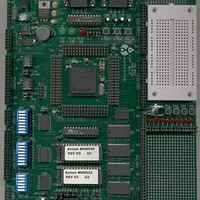MPC555CME Freescale Semiconductor, MPC555CME Datasheet - Page 846

MPC555CME
Manufacturer Part Number
MPC555CME
Description
KIT EVALUATION FOR MPC555
Manufacturer
Freescale Semiconductor
Type
Microcontrollerr
Datasheet
1.MPC555CME.pdf
(966 pages)
Specifications of MPC555CME
Contents
Module Board, Installation Guide, Power Supply, Cable, Software and more
Processor To Be Evaluated
MPC555
Data Bus Width
32 bit
Interface Type
RS-232
For Use With/related Products
MPC555
Lead Free Status / RoHS Status
Contains lead / RoHS non-compliant
- Current page: 846 of 966
- Download datasheet (13Mb)
D.12 Period/Pulse-Width Accumulator (PPWA)
MPC555 / MPC556
USER’S MANUAL
The period/pulse-width accumulator (PPWA) algorithm accumulates a 16-bit or 24-bit
sum of either the period or the pulse width of an input signal over a programmable
number of periods or pulses (from one to 255). After an accumulation period, the algo-
rithm can generate a link to a sequential block of up to eight channels. The user spec-
ifies a starting channel of the block and number of channels within the block.
Generation of links depends on the mode of operation.
Any channel can be used to measure an accumulated number of periods of an input
signal. A maximum of 24 bits can be used for the accumulation parameter. From one
to 255 period measurements can be made and summed with the previous measure-
ment(s) before the TPU interrupts the CPU, allowing instantaneous or average fre-
quency measurement, and the latest complete accumulation (over the programmed
number of periods).
The pulse width (high-time portion) of an input signal can be measured (up to 24 bits)
and added to a previous measurement over a programmable number of periods (one
to 255). This provides an instantaneous or average pulse-width measurement capa-
bility, allowing the latest complete accumulation (over the specified number of periods)
to always be available in a parameter.
By using the output compare function in conjunction with PPWA, an output signal can
be generated that is proportional to a specified input signal. The ratio of the input and
output frequency is programmable. One or more output signals with different frequen-
cies, yet proportional and synchronized to a single input signal, can be generated on
separate channels. See Motorola TPU Progamming Note
mulator TPU Function (PPWA), (TPUPN11/D).
Figure D-21
function.
shows the host interface areas and parameter RAM for the PPWA
TPU ROM FUNCTIONS
Rev. 15 October 2000
Period/Pulse-Width Accu-
MOTOROLA
D-32
Related parts for MPC555CME
Image
Part Number
Description
Manufacturer
Datasheet
Request
R

Part Number:
Description:
MPC555 Interrupts
Manufacturer:
Freescale Semiconductor / Motorola
Datasheet:
Part Number:
Description:
Manufacturer:
Freescale Semiconductor, Inc
Datasheet:
Part Number:
Description:
Manufacturer:
Freescale Semiconductor, Inc
Datasheet:
Part Number:
Description:
Manufacturer:
Freescale Semiconductor, Inc
Datasheet:
Part Number:
Description:
Manufacturer:
Freescale Semiconductor, Inc
Datasheet:
Part Number:
Description:
Manufacturer:
Freescale Semiconductor, Inc
Datasheet:
Part Number:
Description:
Manufacturer:
Freescale Semiconductor, Inc
Datasheet:
Part Number:
Description:
Manufacturer:
Freescale Semiconductor, Inc
Datasheet:
Part Number:
Description:
Manufacturer:
Freescale Semiconductor, Inc
Datasheet:
Part Number:
Description:
Manufacturer:
Freescale Semiconductor, Inc
Datasheet:
Part Number:
Description:
Manufacturer:
Freescale Semiconductor, Inc
Datasheet:
Part Number:
Description:
Manufacturer:
Freescale Semiconductor, Inc
Datasheet:
Part Number:
Description:
Manufacturer:
Freescale Semiconductor, Inc
Datasheet:
Part Number:
Description:
Manufacturer:
Freescale Semiconductor, Inc
Datasheet:
Part Number:
Description:
Manufacturer:
Freescale Semiconductor, Inc
Datasheet:










